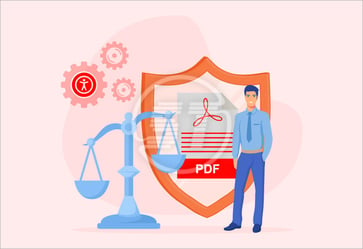Web accessibility has a vast scope. It is not only about screen readers, alt text, color contrast, or keyboard navigation. Yes, these elements are crucial to focus on, there’s another often-overlooked factor that plays a major role in accessibility - page loading speed.
A fast-loading website ensures equal and quick access to digital information and services for everyone. Read along to learn more!
Page loading speed matters in web accessibility – why?
- Users with disabilities rely on assistive technologies
People using screen readers, magnifiers, or voice navigation tools are directly affected by slow websites. Long loading times can cause delays in how assistive technologies interpret and present content, leading to frustration or abandonment.
- Cognitive accessibility and attention span
Slow sites pose significant challenges for people with cognitive disabilities such as ADHD, dyslexia, or memory-related conditions. Delays disrupt focus, increase cognitive load, and make it harder to process information. Faster load speeds help users maintain attention and improve comprehension. Read more about optimizating websites for cognitive accessibility.
- Impact on users with limited internet or devices
Accessibility is not only about disabilities but also about providing similar experience to every single user regardless of technical limitations. Many users - especially in rural areas or developing regions - rely on low-bandwidth connections or older devices. A heavy, slow-loading site creates barriers for them, preventing full participation.
- Mobile accessibility challenges
With more than half of web traffic coming from mobile devices, page speed becomes even more critical. Users with disabilities often rely on mobile assistive features like voice control or zoom. If a site takes too long to load or breaks on mobile, accessibility suffers.
Optimizing page speed while meeting accessibility standards
The Web Content Accessibility Guidelines (WCAG) also address performance of a digital property. For example, the success criterion “Enough Time” ensures users can access content without unnecessary time limits, while “Predictability” emphasizes consistency. A sluggish site undermines both principles, making timely interaction difficult.
Moreover, accessibility regulations like the ADA (Americans with Disabilities Act) and EAA (European Accessibility Act) encourage inclusive web design, and slow-loading websites could be seen as discriminatory if they disproportionately exclude users with disabilities or limited access.
Best practices to improve page speed for accessibility
- Optimize images and media
- Implement lazy loading
- Clean, semantic, and efficient code
- Enable caching and use a Content Delivery Network (CDN)
- Prioritize Core Web Vitals
- Test on real devices and assistive tools
- Reduce server load and improve hosting
Compress images: Use tools like TinyPNG or built-in CMS optimizers to reduce file size without losing quality.
Use next-gen formats: Formats like WebP or AVIF load significantly faster than traditional JPEG or PNG.
Responsive images: Deliver different image sizes depending on device (desktop, tablet, mobile) to avoid loading unnecessarily large files.
Provide alt text: While improving accessibility, alt text also ensures content remains meaningful if images load slowly or fail.
Above-the-fold first: Ensure visible content loads immediately, while off-screen images and videos load as the user scrolls.
Video handling: Replace heavy auto-play videos with thumbnails or preview images that load only when clicked.
Accessibility notes: Provide fallback text or transcripts so users with slow connections don’t miss essential media.
Remove code bloat: Minify CSS, JavaScript, and HTML to cut down unnecessary characters.
Prioritize semantic HTML: Clean, structured code is easier for assistive technologies to process quickly
Limit third-party scripts: Too many tracking codes, chatbots, or widgets can slow pages down and disrupt accessibility.
Browser caching: Store resources locally so returning users don’t reload everything from scratch
Server-side caching: Reduce server response time with cached database queries and pre-rendered content.
CDN benefits: Distribute the website across global servers so users access content from the nearest location - especially important for international audiences.
Largest Contentful Paint (LCP): Ensure the largest element (e.g., hero image, heading) loads within 2.5 seconds.
First Input Delay (FID): Reduce JavaScript complexity so users can interact with the site quickly.
Cumulative Layout Shift (CLS): Avoid unexpected layout shifts by specifying image dimensions and loading ads carefully.
Accessibility alignment: A site that loads predictably helps users with motor and cognitive disabilities navigate without confusion.
Simulate slow networks: Use browser dev tools to throttle speeds and experience the site like users on 3G connections.
Test with screen readers: Tools like NVDA, JAWS, or VoiceOver help identify how slow loading impacts real accessibility.
Mobile-first testing: Given mobile usage dominance, check performance and accessibility together on smaller screens.
Choose reliable hosting: Shared servers may slow down during high traffic; consider cloud or managed hosting for better performance.
Optimize databases: Clean up unused plugins, spam comments, and outdated post revisions to lighten server requests.
Scalable infrastructure: If the site serves thousands of users, scalability ensures speed remains consistent for all.
Also read: Google INP Metric - New Core Web Vitals Metric
The bigger picture: Accessibility and user experience!
Page loading speed sits at the intersection of web usability, inclusivity, and performance. A fast website helps everyone to perceive content correctly - users with disabilities, people on mobile devices, and those with limited connectivity. By making speed a part of the accessibility strategy, organizations ensure that their sites are welcoming, efficient, and inclusive.
In short, web accessibility is about creating a seamless, equitable digital experience for everyone. Slow page loading speed can be just as much of a barrier as missing captions or inaccessible navigation. By optimizing speed, businesses and organizations don’t just improve SEO and conversion rates - they remove obstacles that prevent millions of users from fully engaging with their content.
Enhancing page loading speed is more than just improving performance - it’s a key factor in building an accessible digital experience for everyone. Partner with Skynet Technologies to identify accessibility barriers, optimize performance, and align website with WCAG, ADA, EAA, Section 508 standards. Explore website accessibility remediation services to improve digital presence faster, inclusive, and compliant. Reach out hello@skynettechnologies.com for more information.


